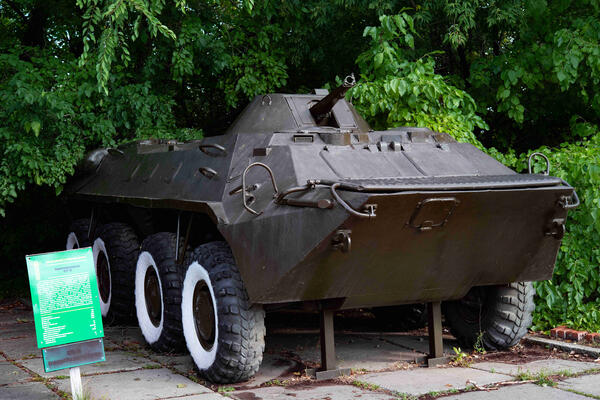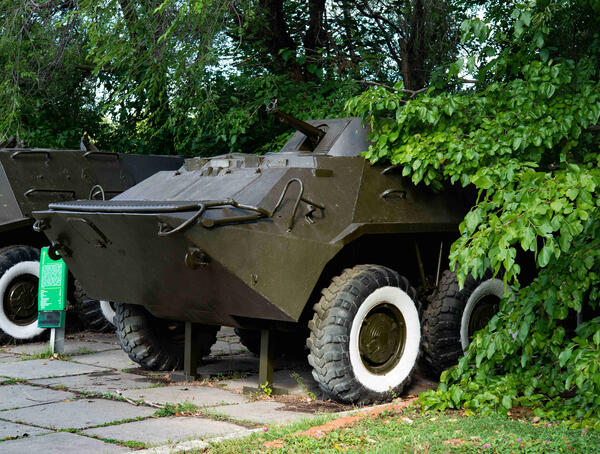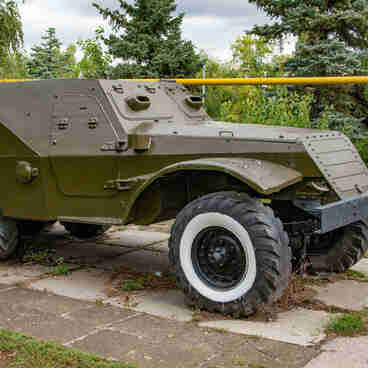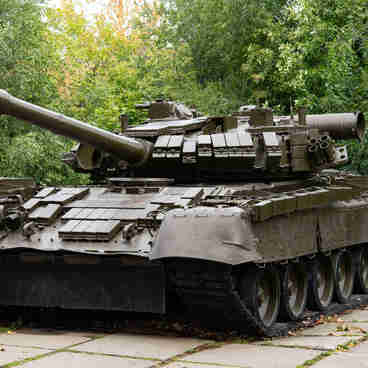The BTR-70 was developed on the basis of the BTR-60PB armored personnel carrier (APC) in the design bureau of the Gorky Automobile Plant. The project was led by the chief designer Igor Sergeevich Mukhin. The BTR-70 armored personnel carrier entered service with the Soviet Army on August 21, 1972.
It was an amphibious eight-wheeled fully armored combat vehicle. The BTR-70 was able to follow tanks, and overcome gun pits, trenches and water obstacles on the move. Since 1976, the armored personnel carrier was mass-produced at the Gorky Automobile Plant, and since 1981 — at the Arzamas Machinery Plant.
The BTR-70 armored personnel carrier was developed on the basis of the fire-seasoned GAZ-50 infantry fighting vehicle. In its general layout, it was similar to the BTR-60PB armored personnel carrier, but had better combat, operational and technical qualities. The armament consisted of a turret machine gun with a KPVT 14.5mm Vladimirov heavy machine gun and a coaxial 7.62mm Kalashnikov machine gun.
The closed sealed hull of the BTR-70 was welded from rolled sheets of armored steel. The thickness of the front parts was 8–10 mm. The turret was also of welded construction, its thickness in the front part was 6 mm. The height of the hull and armored personnel carrier decreased by 185 mm compared to the BTR-60PB.
The APC was equipped with a centralized tire pressure control system. The powerful compressors in this system made it possible to adjust the pressure depending on the conditions and compensate for the pressure loss when a tire was shot.
The maximum speed of the BTR-70 armored personnel carrier when driving on the highway was 80 km/h. It had a great cross-country mobility, and could overcome water obstacles by swimming at a speed of up to 10 km/h. When afloat, the vehicle was propelled by a two-stage hydrojet.
In the 1980s, the BTR-70 was in service with the Soviet Army, as well as with the National People’s Army of the GDR. In the period from 1992 to 1996, the armored personnel carriers of this type were used during the armed conflict in the Pridnestrovian Moldavian Republic.
It was an amphibious eight-wheeled fully armored combat vehicle. The BTR-70 was able to follow tanks, and overcome gun pits, trenches and water obstacles on the move. Since 1976, the armored personnel carrier was mass-produced at the Gorky Automobile Plant, and since 1981 — at the Arzamas Machinery Plant.
The BTR-70 armored personnel carrier was developed on the basis of the fire-seasoned GAZ-50 infantry fighting vehicle. In its general layout, it was similar to the BTR-60PB armored personnel carrier, but had better combat, operational and technical qualities. The armament consisted of a turret machine gun with a KPVT 14.5mm Vladimirov heavy machine gun and a coaxial 7.62mm Kalashnikov machine gun.
The closed sealed hull of the BTR-70 was welded from rolled sheets of armored steel. The thickness of the front parts was 8–10 mm. The turret was also of welded construction, its thickness in the front part was 6 mm. The height of the hull and armored personnel carrier decreased by 185 mm compared to the BTR-60PB.
The APC was equipped with a centralized tire pressure control system. The powerful compressors in this system made it possible to adjust the pressure depending on the conditions and compensate for the pressure loss when a tire was shot.
The maximum speed of the BTR-70 armored personnel carrier when driving on the highway was 80 km/h. It had a great cross-country mobility, and could overcome water obstacles by swimming at a speed of up to 10 km/h. When afloat, the vehicle was propelled by a two-stage hydrojet.
In the 1980s, the BTR-70 was in service with the Soviet Army, as well as with the National People’s Army of the GDR. In the period from 1992 to 1996, the armored personnel carriers of this type were used during the armed conflict in the Pridnestrovian Moldavian Republic.




